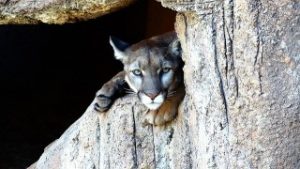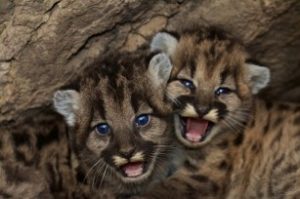
They may look cute, but they are dangerous
The mountain lion, also known as puma, cougar, Puma concolor and sometimes panther or catamount, is a wild big cat belonging to the Felidae family.
It is present in northern, central and southern America. Despite being a large animal, in the family of felids, it is phylogenetically closer to the domestic cat than to other felines of similar size as the leopards. Its closest relative was recently revealed as the yagouaroundi, similar in some aspects (color, round pupil).
Contents
Why does the mountain lion have so many names?
The word “puma” comes from the Amerindian Quechua language and was considered a sacred animal by the Aztecs and Mayans of Mexico, and by the Incas of Peru.
In the English language, there are more than 40 different names used to indicate puma. Some of these names include el leon, ghost cat, cougar, mountain lion, panther, catamount, and painted cat.

Pumas are well camouflaged
However, this animal may have more names, depending on the culture. In some places in Latin America, the cat is said to have as much as 80 names!
In Brazil, the puma is called suçuarana, with the Tupi tongue; from this last term, through a complex transition between one language and another, the English term “cougar” has however been used more in the US, with a far more frequency much more than “puma”.
The name “mountain lion” refers instead to its aesthetic similarity with a lioness (due to the reddish-brown color with the tip of the black tail), while “catamount” is derived from mountain cat (mountain cat).
In Latin America, it is called Puma Conclolor, meaning a “cat with one color”.
In North America, particularly the United States, the word “Panther refers to the puma, although the term “Black Panther” is correctly associated only with the variants affected by melanism of leopards or jaguars, rather than pumas.
In Europe and Asia, “Pantera” means “leopard” and can refer to both the spotted and black leopards.
In South America, “Panther” refers only to the jaguar, both the spotted and black ones.
The melanism gene can be found in a wide variety of felines, including the lion, the tiger, the leopard, the jaguar, the caracal, the jaguarondi, the serval, the ocelot, the margay, and the red lynx.
However, cases of melanism in Puma concolor in North America have never been documented, although urban legends of “black panthers” persist.
These anecdotal reports have particular force on the Appalachians of the eastern United States, a region where it is commonly accepted that Puma concolor has been completely extinct since before the end of the nineteenth century, and where re-established populations have not been documented until 2005.
Description
Recent studies on genes suggest that the puma is closely related to the extinct North American cheetah Miracinonyx. However, recent molecular research seems to indicate a discrete affinity even with the modern cheetah, with which it has some external similarities.
On the other hand, the puma is not a close relative of the real big cats (the lion, the tiger, the jaguar, the leopard, etc.), and is taxonomically classified with the small cats.
However, among the latter, it is clearly the largest (even if the cheetah is included among the “small” felines, the puma will remain the heaviest member of the subfamily).
The pumas that live closest to the equator are the smallest, and grow in size in the populations closest to the poles.
A typical puma is about 60-90 cm high at the withers. Its length, excluding the tail, is on average 130 cm for males and 110 cm for females, to which are added between 66 and 78 cm of the tail.
Its weight varies from 50 to 70 kg for males (but some specimens can even reach 120 kg) and from 35 to 50 kg for females.
Comparing the general dimensions of the larger felids, the puma appears to be in fourth place after the lion, tiger, and jaguar and together with the leopard (while the cheetah, of height similar to the puma, is much lighter).
The hair is short, soft, thick and with a uniform and very variable color.
The front legs have 5 fingers, while the rear 4 with retractable nails.
The pumas are among the most agile animals, being able to make jumps of 4 meters high and 10 meters long.
It holds the record of having the highest jump among all land mammals.
The cougar has in common with the cheetah, a small and round head, a rather long neck, slender body and longer and thinner legs than those of other large felids (although these characteristics are not as accentuated as in the cheetah).
However, the ends of the legs are strong as in the most typical felines.
In the mouth, they have 4 large canines, 12 smaller incisors, and 14 molars, like all Felids.
The pumas emit numerous calls, which differ from male and female, but, unlike the big cats, no roar.
The most famous reference of this animal (described by some North American researchers as Truman Everts similar to that of man) is often attributed in US products to other large felids, in particular, the leopard and the black panther.
Colors of the puma
The general appearance of the puma resembles that of several other felines: the coloring is like that of the lion, while the body proportions vaguely resemble that of a robust cheetah (to which it is perhaps more akin).
Most often the pumas are tawny, reddish blond, or silver gray; the chin and the chest, however, are always whitish. The newly born pumas are beige, dappled, and have rings on the tail; the size fades during the first years of life. There are also abnormally pale and even white pumas. Abnormally dark brown pumas with white abdomens have also been described, especially in South and Central America, called couguar noire by Georges-Louis Leclerc, count of Buffon. There are no authenticated puma accounts with true melanism in North America [1] [2] [3].
How long do pumas live?
In freedom, pumas can reach 18 to 20 years of age. Although their lives usually last a decade, in captivity, they can reach 25 years or more. They can also be domesticated.
What they eat
The pumas hunt mammals of almost all sizes. In North America, among the prey of the puma are deer and reindeer, but also mice, rats, skunks, raccoons, beavers, and opossums, as well as sheep and young cattle.
Other predators such as coyotes and red lynx can also be overwhelmed by the puma.
Because of the urbanization of rural areas, pumas often come into contact with people, especially in areas with large populations of deer, their natural prey.
They have also begun to hunt pets such as dogs, cats, and livestock, but they have rarely resorted to humans as a food source.
In addition to mammals, the puma also feeds on birds and, in some regions, fish. However, it does not eat carrion and also avoids reptiles.
To break down a bigger prey, the puma initially sneaks up on her. From a shorter distance, he jumps on her back and breaks her neck with a strong throat bite.
It uses the body-to-body struggle to subdue the prey and can manage to throw 8 times its weight on the ground with the help of animals (puma females measuring 45 kg have once landed a 360 kg caribou).
Asides, it is several times stronger than a man (estimates range from 5 to 8 times for specimens of 70-80 kg).
Unlike the leopard, the behavior of sheltering prey on trees does not seem to have ever been found in the puma, which perhaps indicates a greater ability to compete with other carnivores in its environment.
How fast is the puma?
The mountain lion has a very strong muscular power in the legs and it is the feline that manages to make the greatest leaps, up to 13.5 m in length and 4.5 in height (unofficially, jumps of 18 meters have been reported).
It can surpass a speed of 80 km/h while racing, but occasionally, it can reach 96 km/h, thus making it the fastest feline after the cheetah. The puma, however, is much stronger than the cheetah.
How pumas reproduce
 Being solitary, the pumas meet only during the mating period, which often, though not exclusively, runs from November to June, for a maximum of six days, before the male again abandons the female a few weeks before giving birth.
Being solitary, the pumas meet only during the mating period, which often, though not exclusively, runs from November to June, for a maximum of six days, before the male again abandons the female a few weeks before giving birth.
The gestation period lasts about three months. A litter may consist of one to seven puppies, usually two or three. Each small puppy weighs 230 to 450 grams, and is 20 to 30 centimeters large. The puppies take solid food after about 6-7 weeks and separate from the mother after about 20 months.
The presence of a spotted coat in small cougars is considered an ancestral trait inherited from the common ancestor of felines and related carnivores (even lions present this characteristic).
It is worthy to note that there are hybrids between different subspecies of pumas in Florida, where foreign animals were introduced in order to increase the low population of Florida panthers, which were decimated years earlier by excessive hunting.
This controversial measure, since it dilutes the genetic purity of the threatened western subspecies, has produced a new generation of more vigorous and reproducing hybrid pumas more quickly than those of pure breed in Florida.
Although the puma is not closely related to the big cats, it was possible to create hybrids with the leopard, which were named pumapards.
We are also aware of hybrids between pumas and ocelots, but in this case, the puppies died shortly after birth.
On some occasions, finally, there have been reports of puma hybrids and jaguars, but the existence of these beings has not yet been proven.
Distribution and habitat
The puma was previously widespread throughout North and South America. No other mammal on the continent had such a spread; it extended from southern Canada through Central America to southern Patagonia.
Nowadays, however, its diffusion is strongly limited and reduced to uninhabited or sparsely populated areas.
In the United States, the pumas have survived the waves of extermination only in the Rocky Mountains, in the deserts and semi-deserts of the southwest and in the marshy areas of the Everglades in Florida.
Through protectionist measures, its territory has been extended again, and in some regions, to the west of the United States, the pumas no longer avoid even the city surroundings.
Ecologically speaking, a puma can be considered the American equivalent of the leopard.
However, the latter is able to adapt in almost all the habitats of its vast range; the prairie, the boreal, temperate and tropical forests, the semi-desert and the high mountain are all part of the vital spaces of this feline.
Only the Arctic tundra and the actual deserts are too hostile habitats.
Puma populations of the United States and Canada
After being hunted almost to extinction in the United States, the puma made its reappearance considerably with 30,000 individuals estimated in the western United States.
In Canada, there are pumas west of the prairies, in Alberta, in British Columbia, and in the southern Yukon. The highest concentration of pumas in North America is found on Vancouver Island in British Columbia.
The pumas are gradually extending their territory towards the east, following streams and riverbeds, and have reached Missouri, Michigan and crossed Kansas, including the large metropolitan area of Kansas City.
Cougars have been spotted on the northern shore of Lake Superior in a horse attack in Ely, Minnesota, in 2004. They are expected to expand their territory soon on the entire eastern and southern United States.
There are still reports of the survival of the remaining population of the eastern puma (Puma concolor cougar) in New Brunswick, Ontario, and Quebec’s Gaspé peninsula.
An estimate of around 4,000 and 6,000 pumas in California and between 4,500 and 5,000 in Colorado was made decades back.
In the latest research carried out in March 2011, the cougar (or mountain lion) was declared extinct from the east of the United States, consequently from the lack of sightings from the 1930s.
How dangerous is it?
The puma is a shy feline, which usually avoids human settlements. Occasionally, however, it can attack humans.
In the United States, there are usually about four such cases each year and victims of the attacks are mostly children. This is the only one of the “little cats” to be considered potentially dangerous for people.
The puma itself has few enemies to fear and man isn’t even among. Only wolves and bears can occasionally prey on young or sick pumas in North America; in South America, the only real threat is the jaguar.
Do pumas attack humans?
Cases of attacks on humans are rare but can occur, especially when human intervention on wild sites reduces the availability of prey for the puma.
About 100 human attacks occurred in the United States and Canada during the period from 1890 to January 2004, with 16 deaths.

A mountain lion prowling
In California alone, there were 14 attacks and 6 deaths. Puma attacks on humans and domestic animals are associated with urban areas between wild places and other more developed urban areas, such as in Boulder or Colorado.
These areas encourage one of the traditional prey of the puma, the mule deer, to get used to the urban areas and the presence of people and wild animals.
The pumas, in such circumstances, can lose their fear of both people and dogs and see them both as prey.
On January 8, 2004, a puma killed and partly ate a mountain biker in the Whiting Ranch Wilderness Park in Orange County, California.
Perhaps it was the same animal that attacked another cyclist in the park the following day, but was subdued by other cyclists. However, a young male puma was killed nearby by forest rangers later that same day.
In California, puma hunting is prohibited, except in very specific circumstances.
This, together with the extinction in California of the wolf and the brown bear, allowed the puma to multiply enormously, since there are no more predators able to steal the game of a puma, although the black bears could be quite strong to do it.
However, California law provides that wild animals that have attacked a human should be killed if they are located.
Threat and importance for men
Even if protected, the puma is still hunted by farmers who are worried about their livestock. However, the species as a whole is not considered to be in danger.
The puma mostly escapes the man. However, in exceptional cases, it can attack adults.
The puma was highly respected among the American Indians. It was given qualities such as command, strength, ingenuity, loyalty, commitment, and courage.
The white colonizers in North America have long hunted the puma, not only to protect their livestock from this anima but also because they aspired to its trophy.



![How To Prevent A Mountain Lion Attack – [Prevention Tips]](https://pestriddance.com/wp-content/uploads/thumbs_dir/puma-2903312_640-1-o76w6711j8fxiroirocharne9j9i38iwute8b8mnd6.jpg)
![Actual Cougar Attacks On Humans – [In Numbers / Statistics]](https://pestriddance.com/wp-content/uploads/thumbs_dir/growth-3078543_640-o7he6fkt413dhgyg7wtpirymylzro0a95c6mtqm0us.jpg)